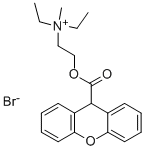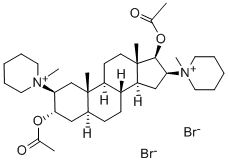ACETYLCHOLINE BROMIDE
Synonym(s):ACh
- CAS NO.:66-23-9
- Empirical Formula: C7H16BrNO2
- Molecular Weight: 226.11
- MDL number: MFCD00011814
- EINECS: 200-622-4
- SAFETY DATA SHEET (SDS)
- Update Date: 2024-12-18 14:07:02

What is ACETYLCHOLINE BROMIDE?
Chemical properties
WHITE TO LIGHT BEIGE ADHERING CRYSTALLINE SOLID
The Uses of ACETYLCHOLINE BROMIDE
Acetylcholine is an endogenous neurotransmitter at cholinergic synapses that amplifies action potential of the sarcolemma thereby inducing muscle contractions. Acetylcholine bromide is used as an acetylcholine receptor agonist to identify, characterize and differentiate among types of cholinergic receptors. Acetylcholine bromide is used as an inhibitor to identify and characterize natural and mutated butyrylcholinesterase(s).
What are the applications of Application
Acetylcholine bromide is an endogenous neurotransmitter at cholinergic synapses
Definition
ChEBI: The bromide salt of acetylcholine.
Biochem/physiol Actions
Endogenous neurotransmitter at cholinergic synapses; amplifies action potential of the sarcolemma thereby inducing muscle contractions.
Purification Methods
The bromide is a hygroscopic solid, but less so than the hydrochloride salt. It crystallises from EtOH as prisms. Some hydrolysis occurs in boiling EtOH, particularly if it contains some H2O. It can also be recrystallised from EtOH or MeOH by adding dry Et2O. [Heilbronn Acta Chem Scand 12 1492 1958, Beilstein 4 IV 1446.]
Properties of ACETYLCHOLINE BROMIDE
| Melting point: | 140-143 °C(lit.) |
| Density | 1.4246 (rough estimate) |
| refractive index | 1.6120 (estimate) |
| storage temp. | -20°C |
| solubility | Methanol (Slightly), Water (Slightly) |
| form | Solid |
| color | Off-White |
| Water Solubility | almost transparency |
| Sensitive | Hygroscopic |
| Merck | 14,86 |
| BRN | 3572117 |
| CAS DataBase Reference | 66-23-9(CAS DataBase Reference) |
| EPA Substance Registry System | Acetylcholine bromide (66-23-9) |
Safety information for ACETYLCHOLINE BROMIDE
| Signal word | Warning |
| Pictogram(s) |
 Exclamation Mark Irritant GHS07 |
| GHS Hazard Statements |
H315:Skin corrosion/irritation H319:Serious eye damage/eye irritation |
| Precautionary Statement Codes |
P264:Wash hands thoroughly after handling. P264:Wash skin thouroughly after handling. P280:Wear protective gloves/protective clothing/eye protection/face protection. |
Computed Descriptors for ACETYLCHOLINE BROMIDE
New Products
Tert-butyl bis(2-chloroethyl)carbamate (S)-3-Aminobutanenitrile hydrochloride N-Boc-D-alaninol N-BOC-D/L-ALANINOL 3-(2,4-Dimethoxybenzyl)dihydropyrimidine-2,4(1H,3H)-dione 7-Bromo-1H-indazole N-octanoyl benzotriazole 3,4-Dibenzyloxybenzaldehyde 4-Hydrazinobenzoic acid Electrolytic Iron Powder Fmoc-Val-Cit-PAB 1,1’-CARBONYLDIIMIDAZOLE R-2-BENZYLOXY PROPIONIC ACID 4-HYDROXY BENZYL ALCOHOL 1,1’-CARBONYLDI (1,2-4 TRIAZOLE) S-2-CHLORO PROPIONIC ACID (2-Hydroxyphenyl)acetonitrile 4-Bromopyrazole 5-BROMO-2CYANO PYRIDINE 5,6-Dimethoxyindanone 5-broMo-2-chloro-N-cyclopentylpyriMidin-4-aMine 1-(4-Methylphenylsulfonyl)-1H-1,2,3-benzotriazole 1-(2-Chlorobenzyl)-4-nitro-1H-pyrazole 1-(2-Nitrophenyl)-4-phenylpiperazineRelated products of tetrahydrofuran








You may like
-
 Acetylcholine Bromide CAS 66-23-9View Details
Acetylcholine Bromide CAS 66-23-9View Details
66-23-9 -
 Acetylcholine bromide, 99% CAS 66-23-9View Details
Acetylcholine bromide, 99% CAS 66-23-9View Details
66-23-9 -
 Acetylcholine Bromide CAS 66-23-9View Details
Acetylcholine Bromide CAS 66-23-9View Details
66-23-9 -
 Acetylcholine bromide CAS 66-23-9View Details
Acetylcholine bromide CAS 66-23-9View Details
66-23-9 -
 1446013-08-6 Fmoc-His-Aib-OH TFA 98%View Details
1446013-08-6 Fmoc-His-Aib-OH TFA 98%View Details
1446013-08-6 -
 127464-43-1 99%View Details
127464-43-1 99%View Details
127464-43-1 -
 2-ETHYLPYRIDINE 100-71-0 99%View Details
2-ETHYLPYRIDINE 100-71-0 99%View Details
100-71-0 -
 13162-05-5 99%View Details
13162-05-5 99%View Details
13162-05-5